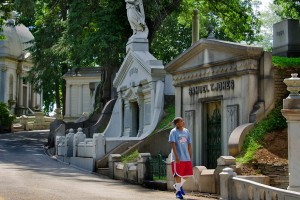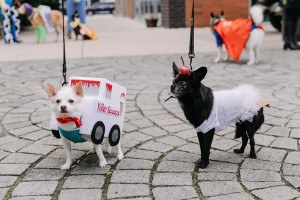I May Live in Pennsylvania, but I’m No Pennsylvanian

Illustration by Mario Zucca
Growing up in Center City, I spent a lot of time in Rittenhouse Square. The park was always full of squirrels, and I loved watching them play with each other and dig in the trash cans for that still-warm McDonald’s french fry. They were at least as cute as the guinea pigs I had at home, and certainly smarter. (No one’s ever accused a guinea pig of being too clever.) I came to see them as fellow city residents — my peers, even. Today, as an adult, I still think of them as friends.
It was a little disconcerting, then, to sit at Thanksgiving dinner this year in Central Pennsylvania, where my boyfriend’s family lives, and witness how quickly a conversation about squirrel color varieties turned into a conversation about eating them. Squirrel recipes and cooking methods were discussed; the adorableness of squirrel paw gestures was not. I confessed I’d never eaten squirrel, which was seen as an anomaly and a shame. And maybe it is, I don’t know. It’s not like I’m a vegetarian, and I’ll try anything once. It’s just that no one ever offered me squirrel.
The dinner-table conversation about squirrel was one of many moments I’ve had in the recent past when I’ve felt like an interloper in my own state, an uninformed naïf who isn’t conversant with even the most basic Pennsylvania traditions. Eating squirrel isn’t unusual in Pennsylvania; the state game commission lists squirrel recipes on its website. But it is unusual in Philadelphia, where I grew up — a place that’s not at all representative of the rest of the state. The Commonwealth has 67 counties; 48 of those are rural. Philadelphia’s East Coast, big-city ethos is another thing entirely.
When I was younger, I didn’t much care about Pennsylvania. When someone asked where I was from, I’d say, “Philadelphia.” I never said, “Pennsylvania.” Then, at some point a few years ago, I realized I’d covered more ground in other states — and other countries, even — than I had in Pennsylvania. That seemed wrong. So I went on a mission to get to know Pennsylvania better. It’s been an interesting journey.
THE DIVIDE BETWEEN Philly and the rest of the state may have complex origins, but in 2016 it serves as a punch line and political obstacle. This magazine’s own Joel Mathis once proposed that Philadelphia secede from Pennsylvania because of budget strife in Harrisburg, where lawmakers from other parts of the state resent having to consider Philadelphia’s “urban” problems. Philadelphians stereotype rural Pennsylvanians as hicks and rubes; people from other parts of the state think of Philadelphia as a cesspool of crime and violence. In the ’80s, Democratic political strategist James Carville infamously described Pennsylvania between Pittsburgh and Philly as “Alabama without black people,” a characterization that took on a life of its own and is now embodied in popular culture: The character of Pennsatucky on Orange Is the New Black started out as a vapid, meth-addled religious extremist. When it comes to national elections, Pennsylvania is fraught with pitfalls as political operatives try to navigate in and around the red state between Philly’s and Pittsburgh’s blue. It’s as if there are two Pennsylvanias: the big cities, and the rest of it.
This kind of divide does exist in other places. When I lived in Austin, Texas, there was definitely a sense that Austin was set apart from the rest of the state — an exception to many Texas rules. Yet people there had an enormous amount of state pride. They were from Texas, and they had the bumper stickers and t-shirts to prove it. Austin was different, sure, but it was fully a part of its own state. This is not the case with Philly and Pennsylvania.
Nathaniel Popkin, an author and historian who’s working on a series of films about our city’s history, says Philadelphia and the rest of Pennsylvania have been at odds since the 18th century. “The divide announces itself in the 1750s and 1760s, when Pennsylvania stock people — Germans and Scottish and Irish Presbyterians — came through the port of Philadelphia and hit the hinterlands of Pennsylvania,” he says. “Their farm economy was intricately linked to that of the city, as a place dependent on trade.”
This all worked well until the pioneers who moved west across Pennsylvania came into conflict with Native Americans. The pioneers wanted protection from the Pennsylvania government, but the Philadelphia Quakers were opposed to violence and weapons and were closely aligned with the American Indians. “So here we have city elite aligned with these ‘other’ people” — Native Americans — “in conflict with frontiersmen,” says Popkin. “City vs. country. Distrust of elites and highfalutin ideas like tolerance and peace.” It was the beginning of a longstanding pattern: “elites allied with minorities whose interests clash with the good white people of the country.”
The relationship got worse with the introduction of the coal industry and the railroads, plus legislative over-districting and corruption in the 20th century. “The little places have power over the city because the Pennsylvania government must authorize every city law — a paradigm that goes back to William Penn,” Popkin says. “Penn could have originally made Philadelphia a city-state with central power, like Venice or Florence. But he didn’t trust such places.”
IN SOME WAYS, Philadelphia does feel a little like its own city-state, one its residents are loath to leave. I know so many people who grew up in Philly and have never ventured even 50 miles beyond it. For some of them, it’s a question of resources, but for others, it’s a lack of interest. As I’ve discovered, those people are missing out. Pennsylvania is well worth exploring.
For one thing, it’s very beautiful, with wonderful physical geography. It also has a variety of place that spans the American experience: the post-industrial landscape of the steel towns; the miles of communities that rely on agriculture; the villages built into mountains that have turned into ski resorts; the riverside communities with strong ties to the water. When you drive through Pennsylvania, it feels like you’re moving through a Ken Burns documentary about American history. Linguistically, the state is especially rich, with five distinct dialects. (Most states have three.)
Everyone I’ve met in Central Pennsylvania has been very nice. As long as we don’t talk about what they think of Philly, things can be pleasant — so pleasant, in fact, that I’ve sometimes forgotten there’s any divide. Other times, the reminders can be harsh.
I once went to Johnstown near Christmastime to learn about the Great Flood of 1889. The museum was closed that day, but I was able to stand at a lookout over the spot where the dam broke and swept the houses away. I felt a jolt of heartache for my fellow Pennsylvanians — the more than 2,000 who died, and their loved ones and townspeople who were left behind to rebuild. These were my people, I thought. My Pennsylvania brethren. What can I say? The interpretive materials got me emotional.
Next I went downtown to Johnstown’s Central Park. There was an enormous tree in the middle of the small park, and a soundtrack with everything from Judy Garland to songs from Frozen. Miniature houses with dioramas inside were situated throughout the park, and I could imagine how at night, with the lights on and families coming through to see the little houses, it would be quite charming. Across from the park, I noticed the headquarters for the Johnstown Tribune-Democrat, which has a statue of a laborer reading the paper, called The Working Man. I had several photos taken of me embracing the man to thank him for reading a newspaper. Down the street from the paper, a shop window facing the park had a menorah painted on it, which I found quite touching. I was welcome here. Pennsylvania, c’est moi.
Then I saw the swastika. It had been etched into the window’s blue paint right next to the menorah. Someone had tried, inexpertly, to cover it up with a sloppy daub of gray paint. But you could still see it. I quickly went back to my car. The truth is, every time I go to other parts of Pennsylvania, I just … I put the Jewish thing aside. I avoid mention of it, even in moments when it would make sense. I know many people who grew up in Pennsylvania but never met a Jew until college. I don’t want to make people uncomfortable, and I don’t want to hear cruel comments. So when traveling in my own state, I pass. But passing is a tricky thing: Sometimes you believe your own bullshit. The swastika in Johnstown brought me back to reality.
NOT ALL CULTURE CLASHES are depressing. Sometimes, they’re pretty funny. Last year, my boyfriend Brad and I went to a bar in Tyrone, PA, to meet his dad for drinks. Brad had long hair and a big beard at the time, so there was plenty of joking about his Jesus-like appearance. Wanting to be part of the crowd, I said, “Oh yeah, and Brad’s been really rockin’ the man-bun these days.” Everyone just stared at me, in silence. It was like I was speaking Klingon. Brad explained: “I told her not to talk like that here. She’s from Philadelphia.”
Another time, Brad’s father and his friend were talking about “camp,” which sounded a lot like my childhood overnight camp: gossiping friends, sporting events, communal meals. But I was confused: My camp was a Jewish overnight camp, with ice-cream socials and musical theater. These guys were still going to camp, at their age. Were they … counselors? Turns out they were talking about hunting camp. I’m glad I didn’t make a clever Klingon remark that time.
I suppose I can be forgiven for not having heard about hunting camp. Of all the chasms between Philadelphia and the rest of the state, none is as wide as the approach to hunting. When I was growing up, everything I knew about hunting came from Bugs Bunny cartoons. None of the adults I knew were at all interested in it. Their attitude was, “Why go into the woods, with all those bugs, to kill something for dinner when you can just buy it at Acme? Please.” But growing up in Tyrone, my boyfriend got off school the first day of hunting season each year; it was treated as a state holiday. I don’t think any child in Philadelphia has any idea when the first day of hunting season is.
Two years ago, Delaware-based Dogfish Head Brewery released a beer called “Pennsylvania Tuxedo.” I was flummoxed. I know what a Canadian tuxedo is (head-to-toe denim), but I’d never heard of a Pennsylvania tuxedo. It turns out it’s a Woolrich hunting ensemble that wouldn’t be seen in Philadelphia outside of Halloween. The beer, according to Dogfish Head, “pays homage to the flannel-suited hunters and gatherers who dwell deep in the backcountry of north-central PA.” It should be called the Pennsylvania-Except-Philadelphia-Tuxedo.
Personally, I’d like to go hunting one day, because I think it would finally turn me into a
vegetarian. Could I kill an animal? I can’t imagine it. Maybe an up-close encounter with my own hypocrisy would do the job all those PETA videos never have. Then again, if I go vegetarian, I’ll never get to try squirrel. That’s for the best, I suppose. How would I explain myself to all my friends on the way to the train station? They’re Philly squirrels, after all. They don’t get the rest of the state.
Published as “The Spikol Chronicles” in the February 2016 issue of Philadelphia magazine.


